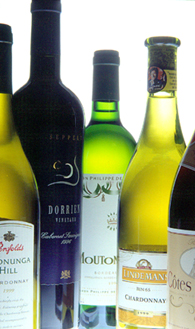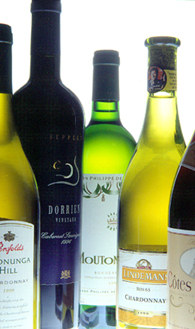If you have practised the moves in Part 1 and have performed well, you may well be acknowledged as the wine expert amongst your peers. If so, you may be invited to recommend wines on behalf of your less knowledgeable friends.

Answering that question may open a Pandora's box as it often turns out that the inquirer already knows about a certain wine and simply wants to ask you about it. Take on the role of the accommodating 'guide' instead. Tell your inquiring friends not to be fazed by shelves at a supermarket or wine shop overflowing with bottles of all shapes and labels. Say that they can easily negotiate their way around a shop if they understand that wines can be sorted and categorised by:
� Colour (red, white, ros�)
� Body (light bodied or low alcohol content of between 8% and 10%, medium bodied and heavy bodied or high alcohol content of up to 14%)
� Style (still wines, sparkling wines/Champagnes, fortified or higher alcohol wines such as sherry and port)
The Two World Divide
But how does one locate the right bottle when faced with aisle upon aisle of wine? Well the first thing to realise is that there are two worlds of wine - Europe vs. The Rest of the World.
To tell the difference between European wines and those from The Rest of the World, all you have to remember is this. Most of the European countries name their wines after regions whilst the Rest of the World (fondly referred to as The New World Countries) have wines that are named after the wine grape varieties.
European wine history is thousands of years old; which is perhaps why European wines are called Old World wines.
Vines have been known to grow near the Black Sea as far back as 10,000 years ago! Vines were cultivated in 4000 B.C. indicating that wines may have been consumed since the beginning of civilisation.
The origins of wine have been traced back to Persia (Iran) and Babylon (Iraq). Later, wines were enjoyed in Egypt. It was only in 7 B.C. that vines were transported to all parts of the Mediterranean, thus laying the foundations for viticulture and later, winemaking in the area.
Although the Greeks brought vines to Europe, it is the Romans who are credited for starting vineyards in France. However wine production evolved only from the mid 1800s when French scientist Louis Pasteur discovered the process of fermentation and wine conservation. At that time wines were contained in various vessels such as barrels, large long jars called amphorae, pottery and stoneware jugs. Commercial wine production was driven by the use of glass bottles that were produced by the English in the 1800s.
So the next time someone at dinner mentions that Europeans invented wine, you can tell them otherwise.
The New World countries (USA, Australia, South Africa, Chile, Argentina, New Zealand, China, India, Japan, Indonesia, Thailand etc.) are known as such because they began producing wine no earlier than 300 years ago. Even though the history is recent in the New World, the wine is of comparable quality and should not be sniffed at. In fact, many Old World wines face stiff competition by their New World counterparts.
| Old World Wine | New World Wine |
| French Bordeaux(sub regions of Medoc, Pauillac, Margaux, St. Emilion, Pomerol, etc.) | Cabernet Sauvignon or Merlot or blends of both |
| French Red Burgundy (sub regions of Pommard, Nuit St. Georges, Vosne Romanee, etc) | Pinot Noir |
| French North Rh�ne Valley red wines (Gigondas, Hermitage, Cornas, etc.) | Shiraz/Syrah |
| French South Rh�ne Valley red wines (Chateauneuf du Pape) | Grenache blended with other varieties |
| French White Burgundy (sub regions of Chablis, Macon, Montrachet, etc.) | Chardonnay |
| French Loire Valley white wine (Sancerre, Pouilly Fume, Touraine, etc.) | Sauvignon Blanc |
| French Alsace white wine | Riesling or Gew�rztraminer |
| German white wine from the Rheingau region | Riesling |
| German white wine from the Mosel-Saar-Ruwer region | Riesling and MullerThurgau |
| Italian Tuscany red wine | Sangiovese and Cabernet Sauvignon |
| Spanish Rioja | Tempranillo |
The table illustrates similarities between Old World and New World wines. If someone tells you they like Australian Cabernet Sauvignon or Californian Cabernet Sauvignon, you could suggest a Bordeaux from France. Alternatively, a French Burgundy drinker might find Pinot Noirs (pronounce: pee-noh nwah) or Chardonnays (the white wine equivalent) from any of the New World countries to their liking.
The Tastes and Flavours of Wine
If your friends lean toward certain styles of wine, here are some wines you can suggest!

Sauternes, Barsacs or Cadillacs of France, Late Harvest or Botrytis wines of Australia, Canadian Ice Wine, German Eiswein, German Auslese, Beerenauslese or Trockenbeerenauslese, Italian Recioto, Hungarian Tokaji.
Dry White Wine (with citrus aromas or herbal flavours):
Chenin Blanc from South Africa, wines from the Loire Valley, Sauvignon Blanc from New Zealand, Australia, California and Chile.
Medium Dry White Wines (with lychee or spicy flavours):
Alsace Gew�rztraminersand Gew�rztraminers from Germany and most of the New World
Heavy Bodied Dry White Wine (with fruity aromas, creamy textures and vanilla and oak flavours):
White Burgundy and Chardonnays from most of the New World.
Light Bodied Dry Red Wine:
Beaujolais, Valpolicella, Grenache, Pinot Noir and many Red Burgundies
Medium Bodied Dry Red Wine:
Merlot, Syrah blends and Cabernet Franc.
Heavy Bodied Dry Red Wine:
Barolo, Cabernet Sauvignon, Zinfandel, Australian Shiraz, Tuscan (Montalcino or Montepulciano)
Finally if pressed for some wine examples, tell your friends that taste and wine preferences are a personal thing. You would rather not spoil the fun for them. That is, the fun in selecting various wines and discovering which styles they like.
Any drinker knows that drinking alone is no fun but drinking with company is always an occasion. A light bodied red wine such as Pinot Noir or a light white wine such as a Riesling is a good lunch companion. Cabernet Sauvignon is often the red wine of choice over dinner. And for weddings, anniversaries and, of course, seductions, there is simply no wine like the bubbling magic of Champagne.











 Printable Version
Printable Version










Reader's Comments
Be the first to leave a comment on this page!
Please log in to use this feature.